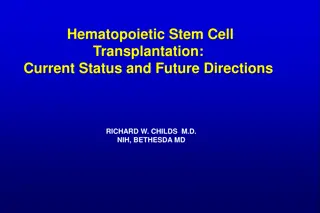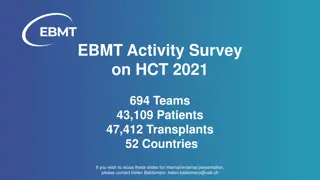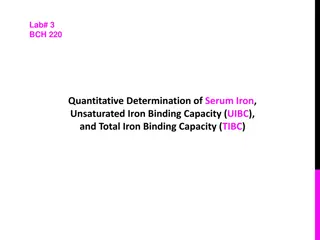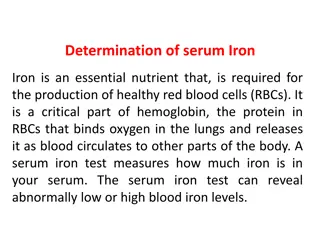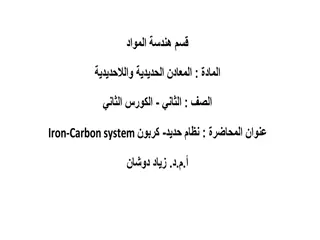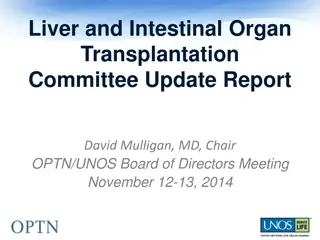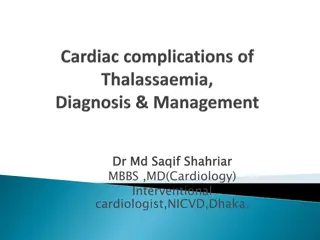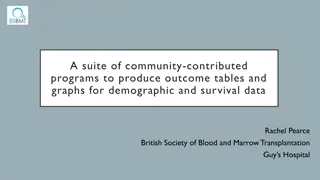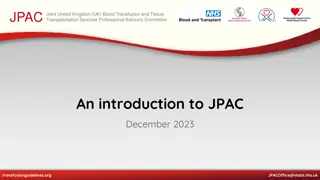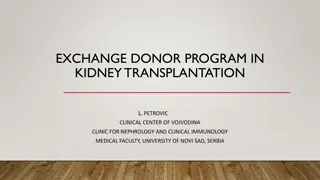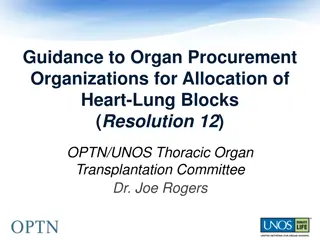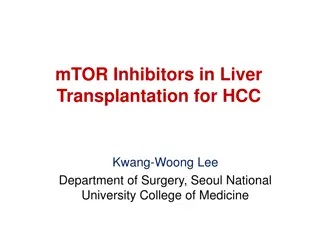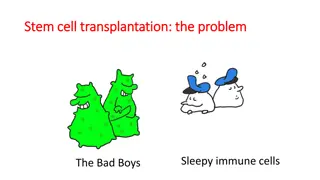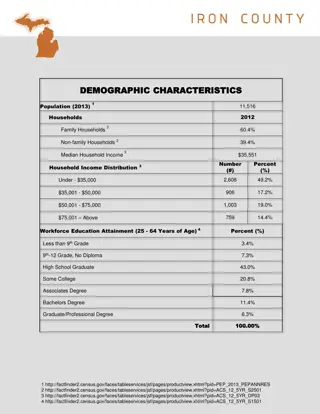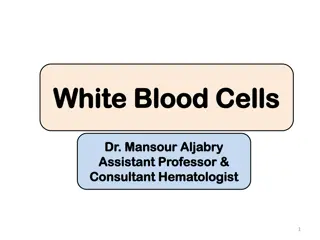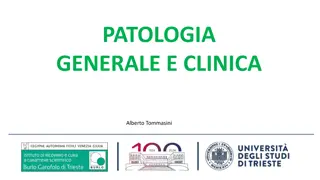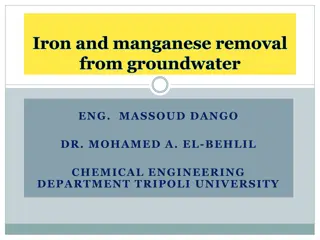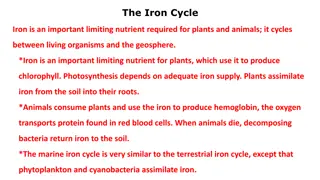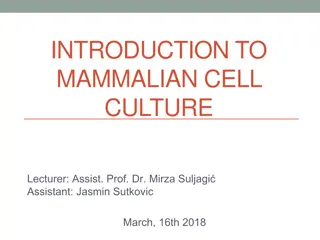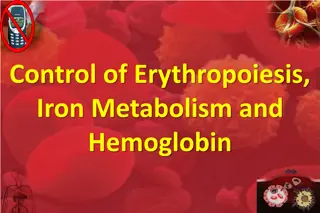Iron Overload and Allogeneic Hematopoietic Cell Transplantation: A Comprehensive Overview
Iron overload is a significant concern before and after transplantation, impacting outcomes in conditions like thalassemia and leukemia. Serum ferritin levels play a crucial role in predicting non-relapse mortality and overall survival post-transplantation. Understanding the causes and effects of raised serum ferritin levels is essential for managing complications and improving treatment outcomes in patients undergoing allogeneic HCT.
Download Presentation

Please find below an Image/Link to download the presentation.
The content on the website is provided AS IS for your information and personal use only. It may not be sold, licensed, or shared on other websites without obtaining consent from the author. Download presentation by click this link. If you encounter any issues during the download, it is possible that the publisher has removed the file from their server.
E N D
Presentation Transcript
Iron overload before and after transplantation Maria Gilleece Leeds Teaching Hospitals Trust
BSBMT: Adult Allo-HCT 2009-2014 AML ALL CML CLL Other leukaemias Myeloma Hodgkin NHL MDS Aplasia MPN Miscel MDS AML ALL BSBMT Annual Report 2017
Non-relapse mortality (NRM) & Comorbidity in allo-HCT Survival by HCT CI (Haematopoietic Cell Transplant Comorbidity Index) NRM by centre size D+100 - 8% 1 year - 19% BSBMT Annual Report 2017
Thalassaemia & HCT: Iron overload is a risk factor for inferior outcome Pesaro risk factors for allo-HCT in paediatric thalassaemia Hepatomegaly >2 cm Liver fibrosis Chelation history Class 1 No No Regular Class 2 No/Yes No/Yes Regular Class 3 Yes Yes Irregular Lucarelli 1990; Baronciania 2016
Serum Ferritin & MAC allo-HCT Armand 2007
Refinement of the HCT-CI HCT-CI Hematopoietic Cell Transplant Comorbidity Index Pre-allo-HCT ferritin, albumin & platelet count independently predict NRM and OS after allogeneic HCT. Sorror 2005, 2008,2015, Vaughn 2015
Ferritin Conserved Algae ..humans Intra-cellular iron storage Free iron is toxic Serum ferritin Iron carrier Haemosiderin Ferritin aggregates Lysosomal proteolysis Releases iron slowly Prussian blue reaction. Nanocage Complex of 24 protein subunits Light & Heavy chains Ferro-oxidase activity Store @ 4,500 atoms of Fe+++ Apoferritin protein shell
Causes of raised serum ferritin Iron overload Haemachromatosis Transfusions Inflammatory conditions metabolic syndrome diabetes haemophagocytoc lymphohistiocytosis Liver disease Viral hepatitis Alcoholic hepatitis Non-alcoholic steatosis Malignancy HIV Acute & early infection Advanced disease with opportunistic infection
Why are raised ferritin levels associated with reduced OS after HCT? Ferritin levels Raised as part of acute phase response Underlying process e.g. inflammation Raised in iron overload Iron deposition in tissues directly toxic Labile non-transferrin iron Reactive oxygen species free radicals
Iron is both essential and toxic Essential to function of many proteins & enzymes Iron-sulphur cluster proteins Ribonucleotide reductase Hemoproteins haemoglobin, myoglobin mitochondrial electron transport chain hepatic cytochromes.
Iron is both essential and toxic Toxic Non-transferrin bound Iron Reactive oxygen species tissue damage & inflammation lipid peroxidation oxidation of amino acids & consequent protein protein cross- links protein fragmentation DNA damage defective chemotaxis & phagocytosis by neutrophils & macrophages, decreased NK cell activity
Cells of the iron cycle Duodenal enterocytes Dietary iron absorption Erythroid precursors iron utilization Reticuloendothelial macrophages iron storage and recycling Hepatocytes iron storage and endocrine regulation http://jasn.asnjournals.org/content/18/2/394/F2.expansion
Distribution of iron 100% other cells gut 90% marrow reticulo- endothelial system 80% 70% 1-2 mg 60% liver 50% 40% 30% red blood cells 20% 1-2 mg 10% 0% Total @ 4g
Hepcidin & iron homeostasis Erythopoietic Fe requirements, Erythroferrone, Hypoxia Hepcidin Hepatocytes & Kupffer cells Duodenal enterocytes Splenic macrophages Ganz & Nemeth 2012
Hepcidin & iron homeostasis Intra/extracellular [Fe] Inflammation (IL-6) Hepcidin Duodenal enterocytes Hepatocytes & Kupffer cells Splenic macrophages Ganz & Nemeth 2012
MEASUREMENT OF IRON OVERLOAD
Iron status: Laboratory tests Serum ferritin Available & inexpensive Acute phase reactant Infection Inflammation Anoxia Transferrin Saturation, Serum Fe & Total Iron Binding capacity Track RBC transfusions
Measuring iron overload - alternatives to serum ferritin Liver biopsy Magnetic Resonance Imaging (MRI) Ferriscan liver R2 MRI Cardiac T2* MRI Transient Elastography (fibroscan) Superconducting Quantum Interference Device (SQUID) Pileggi 2017
R2-MRI & liver iron content Savani 2013
Serum Ferritin vs SQUID* *Superconducting quantum interference device biomagnetic liver susceptometry SQUID pre-HCT (80% RIC) Myeloid malignancies x142 median age 54.5y >100 ng/mL & fungal infection x3.08 (CI 1.43-6.63) Jacobi 2016; Pileggi 2017
Increased iron absorption Hereditary haemachromatosis HFE mutations Mutations of regulators of intestinal absorption Ferroportin, hepcidin, hemojuvelin ..... Ineffective erythropoiesis & hepcidin suppression Thalassaemia major/intermedia, sideroblastic anaemias, Diamond Blackfan anaemia .. Chronic liver disease Alcohol, chronic hepatitis & non-alcoholic fatty liver disease
Increased iron intake Red cell transfusion Haemolytic anaemia, myelodysplasia, aplastic anaemia . Excess dietary iron Genetic component Haem arginate infusions Acute intermittent porphyria
Iron overload in haematological malignancy Cytotoxic agents Suppression of erythropoiesis Anemia results in suppression of hepcidin Ferroportin open Iron uptake from gut Iron export Hepatocytes Reticuloendothelial system
Transfusion related iron overload 1U RCC = 200-250 mg iron 20-25 u = @Ferritin 1000 ng/mL 2U/month 4 years >20g in 4 y Batts 2007
Transfusion related iron overload Liver hepatic fibrosis cirrhosis hepatocellular carcinoma cardiac arrhythmia congestive cardiac failure glucose intolerance growth retardation Heart Endocrine organs Reduced life expectancy Iron overloaded
Iron toxicity NTBI non-transferrin-bound iron LPI Labile plasma iron Angelucci & Pilo 2016
Iron overload is frequent pre-HCT Prospective study pre-HCT x48 AML, MDS or ALL Myeloablative HCT Se Ferritin >1000 ng/mL 69% >2500 ng/mL 23% MRI T2* Liver Iron Content >ULN 85% 5 mg/gDW 19% Cardiac Iron overload 1 patient Armand 2014
Pre-allo-HCT iron chelation Retrospective N=101 Desferrioxamine . Deferasirox Leitch 2011, Lee 2009
Meta-analysis 4 prospective studies Pre-allo HCT ferritin 1000-2500 ng/mL is prognostic for survival Armand 2014
Meta-analysis 4 prospective studies Armand 2014
IRON OVERLOAD, HCT & MYELODYSPLASTIC SYNDROMES (MDS)
Iron overload in MDS Disease related Ineffective erythropoiesis Increased gut absorption Hepcidin levels vary between subtypes Therapy related Red cell transfusions Malcovati 2005, Pilegia 2017
Transfusion burden & MDS RA, RARS, MDS del(5q-) RCMD or RCMD-RS Transfusion burden (u/month) Reduced OS & LFS Independent of cytogenetics Cardiac failure Excess non-leukaemic mortality P 0.01 Se ferritin > 1,000 ng/mL) Reduced OS, HR of 1.36 per 500 ng/mL increment in transfused RA/RARS RAEB Transfusion burden had no effect on LFS Malcovati 2005, Pilegia 2017
MDS, ferritin, transfusion & HCT n=357 Retrospective, Myeloablative conditioning Transfusion dependency associated with reduced OS, increased NRM & aGVHD. Ferritin effect on OS & NRM even when adjusted for transfusion history Alessandrino 2010, GITMO
MDS, transfusion & HCT n=201 Retrospective, Myeloablative conditioning EBMT 2000-2005 primary MDS 1/3 RA, RARS or 5q- upfront MAC allo-HCT >20u vs 20u MVA Inferior outcomes >20u OS HR 1.99 NRM 1.89 RI 2.67 Cremers 2016, EBMT
MDS & Iron chelation ELN 2013 Chelating agents Desferrioxamine Se Ferritin > 1000 ng/mL Daily infusions, bd bolus Urinary iron excretion Deferiprone Agranulocytosis Deferasirox Diarrhoea & other GI symptoms Rashes Renal toxicity RA, RARS, or MDS isolated 5q- transfusion-dependent serum ferritin level > 1000 ng/mL after @25 units of red cells Potential allo-HCT candidates Prior to conditioning
Peri-transplant Iron overload Conditioning Mobilisation of marrow iron deposits Rise in LPI & NTBI .& ROS Increased rate of infections Severe GvHD Sinusoidal obstructive syndrome
Labile Plasma Iron & myeloablative conditioning in auto-HCT Labile plasma iron : Redox-active subset of non-transferrin bound iron Naoum 2014
Iron-chelation peri-allo-HCT Pilot clinical trial MDS/acute leukemia undergoing MA-HSCT Serum ferritin >1000 ng/mL & LIC >5 mg/gdw Deferoxamine from enrolment Labile plasma iron avid >2 weeks prior to allo-HCT until day 1 IV or SC over 8 12 h N=5 slow accrual early closure 1/5 vasopressor support LPI detectable in 2/5 during conditioning Median FU 20m, no SOS, death, relapse or III/IV GVHD chronic GVHD 2/5 Practical challenges in delivery Armand, 2013
Iron overload is frequent post-HCT Rose 2007
Complications of iron overload within the first year post-HCT Non-relapse mortality increased allogeneic & autologous recipients Infections mucormycosis invasive aspergillosis listeria monocytogenes & other infections Acute GVHD possibly Hepatic sinusoidal obstruction syndrome possibly Majhail 2008
Complications of iron overload beyond 1 year post-HCT Infections mucormycosis invasive aspergillosis & other infections Chronic GVHD No clear evidence available, decreased risk reported with elevated ferritin Liver function abnormalities Iron overload increases risk Cardiac late effects Iron overload might increase risk Majhail 2008
Reducing iron overload post HCT Venesection programme Safe, effective & extensive experience Hb 110 g/L - erythropoietin Venous access & inconvenience Desferrioxamine Safe, effective & extensive experience Short half-life, subcutaneous route, ototoxicity 8-12 hours 5-7 days / week - Compliance Deferasirox Oral iron chelator - nephrotoxicity Deferiprone Oral iron chelator - hepatotoxicity
Deferasirox after HCT Prospective, n=22; mild-moderate nephrotoxicity Vallejo 2014
Conclusions - Pre-allo HCT Candidates for allo-HCT Consider iron-chelation if feasible Elevated ferritin pre-allo HCT adverse prognostic factor overall survival & possibly non-relapse mortality, SOS, infections & GVHD adds information to HCT-CI score consider causes Reactive status - acute phase reactant Optimise any probable causes Iron overload Establish a transfusion history Prognostic role of iron overload remains unclear EBMT observational study of iron toxicity in MDS in analysis Prospective large trials of chelation in allo-HCT awaited Reasonable to consider chelation in transplant candidates Armand 2014


